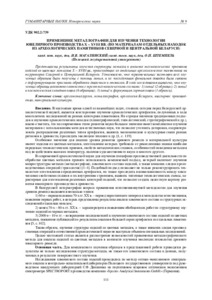Please use this identifier to cite or link to this item:
https://elib.psu.by/handle/123456789/25626Full metadata record
| DC Field | Value | Language |
|---|---|---|
| dc.contributor.author | Магалинский, И. В. | - |
| dc.contributor.author | Штемпель, О. П. | - |
| dc.contributor.author | Mahalinski, I. | - |
| dc.contributor.author | Chtempel, O. | - |
| dc.date.accessioned | 2020-10-07T09:10:36Z | - |
| dc.date.available | 2020-10-07T09:10:36Z | - |
| dc.date.issued | 2020 | - |
| dc.identifier.citation | Магалинский, И. В. Применение металлографии для изучения технологии ювелирного производства Х – XVIII вв. (по материалам отдельных находок из археологических памятников Северной и Центральной Беларуси) / И. В. Магалинский, О. П. Штемпель // Вестник Полоцкого государственного университета. Серия A, Гуманитарные науки. - 2020. - № 9. - С. 111-115. | ru_RU |
| dc.identifier.issn | 2070-1608 | - |
| dc.identifier.uri | https://elib.psu.by/handle/123456789/25626 | - |
| dc.description.abstract | Представлены результаты изучения структуры металла и внешних технологических признаков изделий из цветных металлов Х – XVIII вв., происходящих из отдельных археологических памятников на территории Северной и Центральной Беларуси. Установлено, что первоначальные заготовки всех изученных образцов были получены с помощь литья, а их последующая финальная доводка была связана с деформирующими приемами обработки давлением и отжигом. В ходе исследования выявлено, что изученные образцы возможно соотнести с тремя технологическими схемами: 1) литьё (2 образца); 2) литьё и косметическая холодная ковка (6 образцов); 3) литьё и формующая горячая ковка (1 образец).= the results of studying the metal structure and external technological features of non-ferrous metal products of the 10th-18th centuries originating from archaeological sites on the territory of Northern and Central Belarus are presented. It was found that the initial blanks of all the studied samples were obtained using casting, and their subsequent final refinement was connected with deforming methods of pressure and annealing treatment. the research revealed that the studied samples can be correlated with three technological schemes: 1. casting (2 samples); 2. casting and cosmetic cold forging (6 samples); 3. casting and forming hot forging (1 sample). | ru_RU |
| dc.language.iso | ru | ru_RU |
| dc.publisher | Полоцкий государственный университет | ru_RU |
| dc.relation.ispartof | Веснік Полацкага дзяржаўнага ўніверсітэта. Серыя А, Гуманітарныя навук | be_BE |
| dc.relation.ispartof | Herald of Polotsk State University Series A, Humanity sciences | en_EN |
| dc.relation.ispartof | Вестник Полоцкого государственного университета. Серия A, Гуманитарные науки | ru_RU |
| dc.relation.ispartofseries | Серия A, Гуманитарные науки;2020. - № 9 | - |
| dc.rights | open access | ru_RU |
| dc.subject | Государственный рубрикатор НТИ - ВИНИТИ::ОБЩЕСТВЕННЫЕ НАУКИ::История. Исторические науки | ru_RU |
| dc.subject | Археометаллургия | ru_RU |
| dc.subject | Металлография | ru_RU |
| dc.subject | Археология Беларуси | ru_RU |
| dc.subject | Ювелирное производство | ru_RU |
| dc.subject | Материальная культура | ru_RU |
| dc.subject | Archaeometallurgy | ru_RU |
| dc.subject | Metallography | ru_RU |
| dc.subject | Archaeology of Belarus | ru_RU |
| dc.subject | Jewellery production | ru_RU |
| dc.subject | Material culture | ru_RU |
| dc.title | Применение металлографии для изучения технологии ювелирного производства Х – XVIII вв. (по материалам отдельных находок из археологических памятников Северной и Центральной Беларуси) | ru_RU |
| dc.title.alternative | The Use of Metallography For Studying the Technology of Jewellery Production in the 10th-18th Centuries (Based on Materials of Separate Findings From Archaeological Sites of Northern and Central Belarus) | ru_RU |
| dc.type | Article | ru_RU |
| dc.identifier.udc | 902.2:739 | - |
| Appears in Collections: | 2020, № 9 | |
Files in This Item:
| File | Description | Size | Format | |
|---|---|---|---|---|
| 111-115.pdf | 475.01 kB | Adobe PDF |  View/Open |
Items in DSpace are protected by copyright, with all rights reserved, unless otherwise indicated.